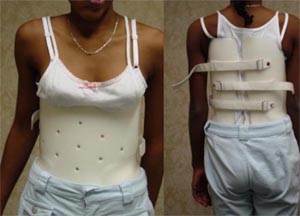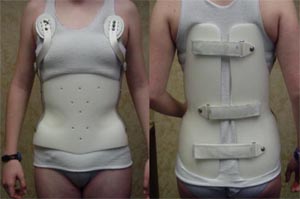Spinal Braces
Spinal Braces
Why we would recommend a brace?
When you visit our office we may recommend that you wear a brace for scoliosis or kyphosis. We might recommend the brace if your curvature is between 20-40 degrees (scoliosis) or 55-70 degrees (kyphosis), as measured on an x-ray, and you are still growing. The goal of bracing is to keep the curve from progressing as you continue to grow, thus preventing the need for surgery. As you are weaned out of the brace, the curve may return to where it began. As long as the curve does not increase further, the brace has done its job.
What types of bracing do we recommend?
The most common brace recommended in our practice is a modern-day, modified Boston model brace. It is an underarm low profile brace. This brace opens in the back. We also may recommend a modified Milwaukee brace for a high thoracic curve or kyphosis, (round back). Our practice has also developed a modified low profile brace for kyphosis, which can be used in certain instances.
The braces are made of light weight plastic and are fitted to your body. There are pads placed, in order to provide pressure on the curve, to give maximal correction. The brace is worn under clothing; you may need to get clothing a little larger to accommodate the brace.
How long is a brace worn?
The brace is worn until you have finished growing. We monitor four growth centers, the femur (hip), iliac crest, humerus, and head of ribs. As you reach skeletal maturity, the growth centers close. On average, girls complete their growth 1 ½ to 2 years after beginning to menstruate or around age 15. Boys complete their growth around age 17.
Once it is decided that you are close to the end of growth, we will begin weaning you out of the brace.
How many hours a day is a brace worn?
It is recommended that you wear a brace 20-22 hours per day, depending on your after-school activity. You may have heard about nighttime or part-time bracing protocols. These have not consistently been found to have as good results as “full-time” bracing which we recommend.
Are there any restrictions?
The brace should not be worn for contact sports and swimming. You may wear the brace for gym and non-contact sports.
Are there any other options other than brace wearing?
For young patients with a great deal of growth remaining (Risser 0,1) a new option is available. The so-called stapling procedure in which small metal staples or clips are inserted into the spine. This is a surgical procedure done with very small incisions. It allows continued growth and flexibility of the spine since it is not a fusion procedure. Early results of this technique are encouraging, correcting curvature in a significant number of patients. This procedure can be discussed with Dr. Lonner to determine if you are a candidate.
How do I begin wearing my brace?
“Breaking-in” your brace is a gradual process taking 10-14 days. You should begin with as many hours as tolerated. If fatigue sets in, remove for one hour, and then replace it. This process is repeated until the brace is worn for the full 20-22 hours per day. You should attempt to wear the brace at night. If you are unable to fall asleep or awaken because of discomfort, remove the brace and try again the next night. It may take several nights until you are acclimated. You can wear the brace to school. If you get tired, remove the brace and take it home and start the process again when you arrive home.
How to wear the brace?
You should bathe or shower daily. Then cornstarch or talcum powder should be applied to the torso of the body, to absorb perspiration. A 100% cotton undershirt without side seams should always be worn under the brace. Make sure to pull the t-shirt tightly down, so that there are minimal wrinkles. Two changes a day are recommended, along with application of cornstarch. You should wear the brace as tightly as possible. If the brace is too loose it will rub the skin and lead to skin breakdown. The more fitted the brace is, the less you will see the brace. If there is skin irritation, remove the brace for 1-2 days, and apply vitamin E ointment.
How to care for the brace?
The brace needs to be cleaned daily. It would be best to clean before showering, so that the brace has time to dry. The brace should be cleaned with witch hazel and rubbing alcohol with a cloth. The brace should be wiped on the outside and inside including the pads. The Velcro straps also need to be cleaned weekly with a pin, in order for the straps to last longer. However, eventually the straps will need to be replaced, if you feel that the straps are not holding the brace closed. If at any point the brace is not fitting properly or is broken, contact the brace maker (orthotist) and our office.
How to care for your body?
It is very important to exercise regularly to maintain muscle tone and body strength. This will make wearing your brace more comfortable. This will also make it easier for you when you begin weaning out of the brace. We recommend that you do 50 sit-ups a day to strengthen your abdominal muscles. A specific exercise program or physical therapy is not necessary. It is important to engage in regular exercise in some form. You should not have any activity restrictions.
Brace Examples
Modified Boston Model underarm brace used for most patients with idiopathic scoliosis
Modification of the underarm brace to allow for correction of kyphosis or high thoracic scoliosis


